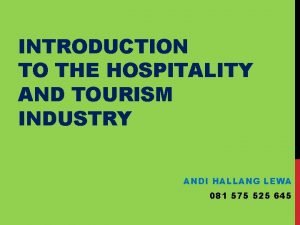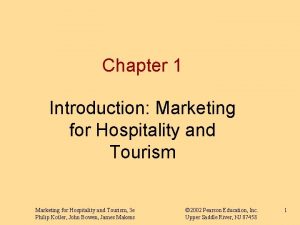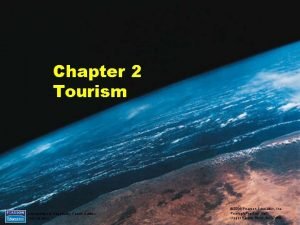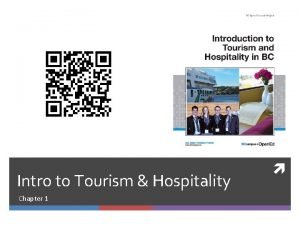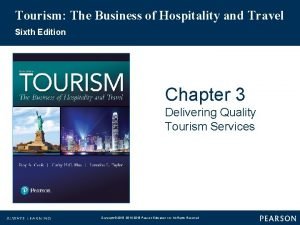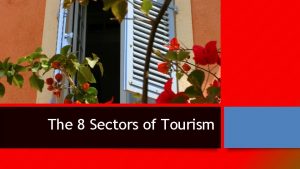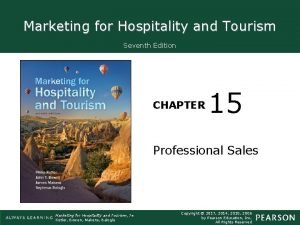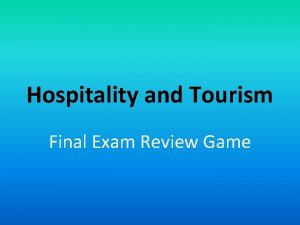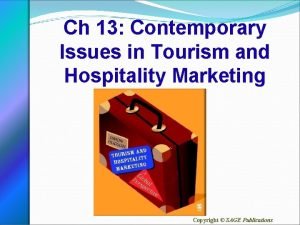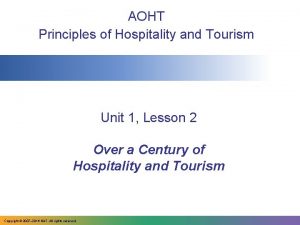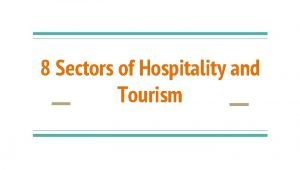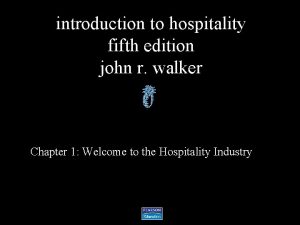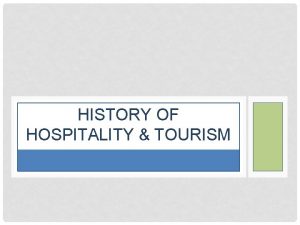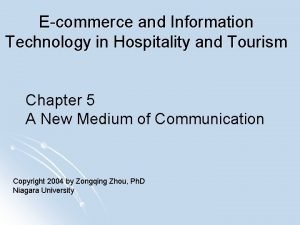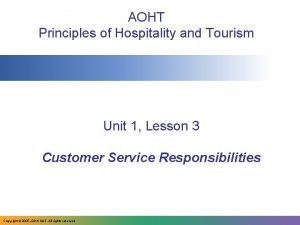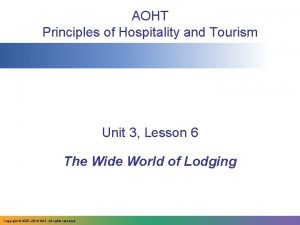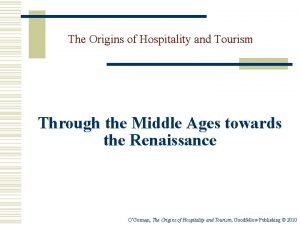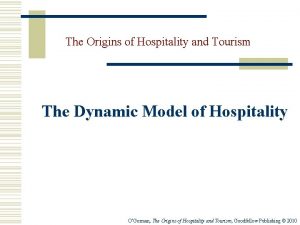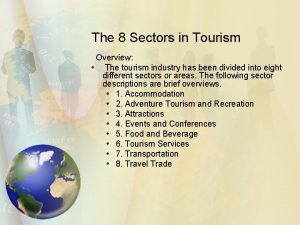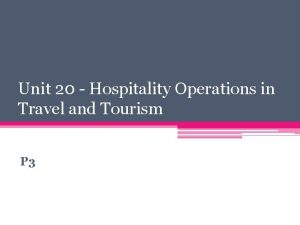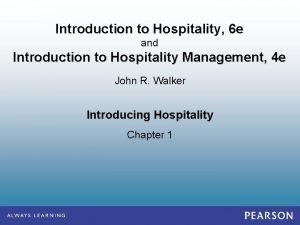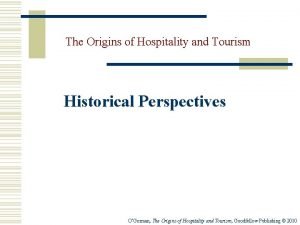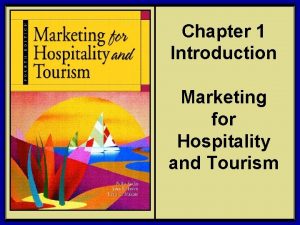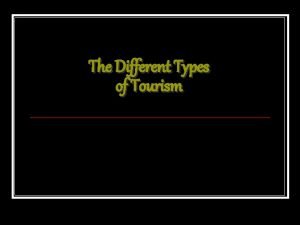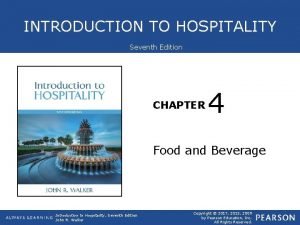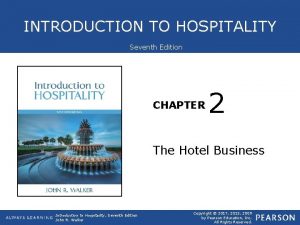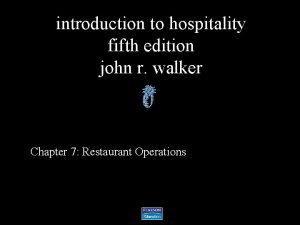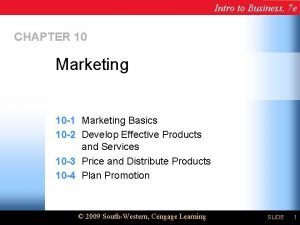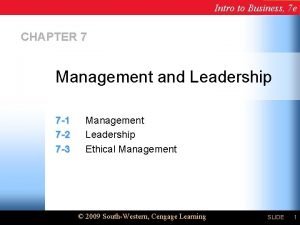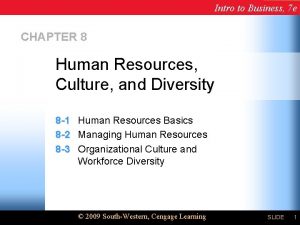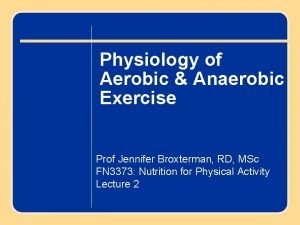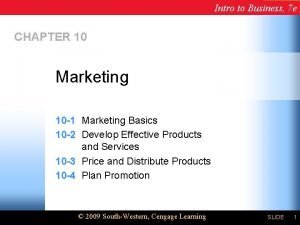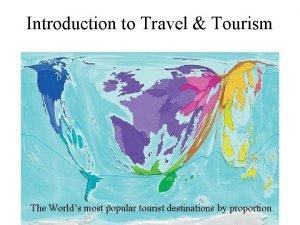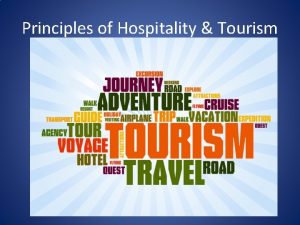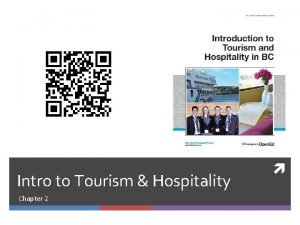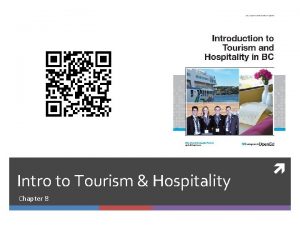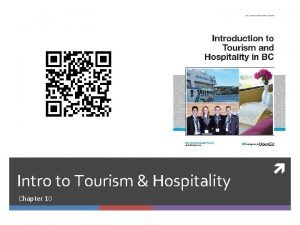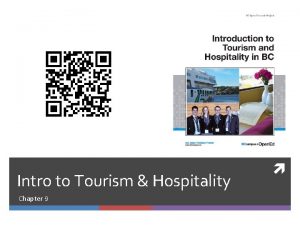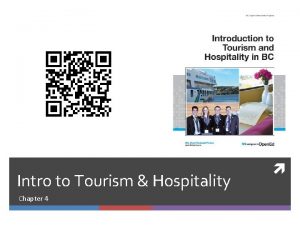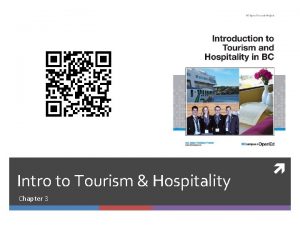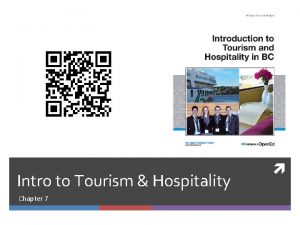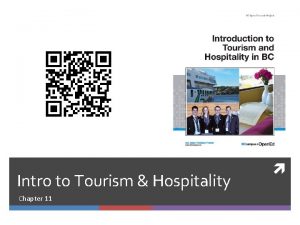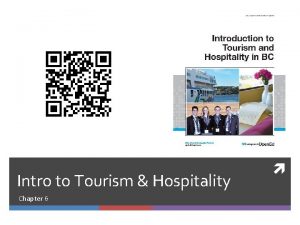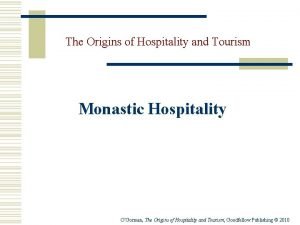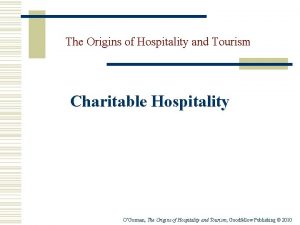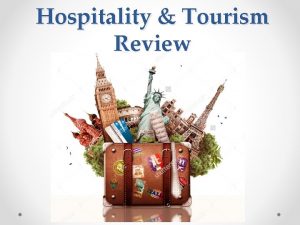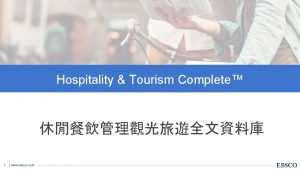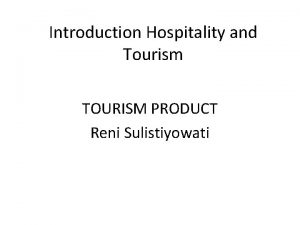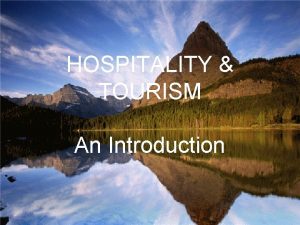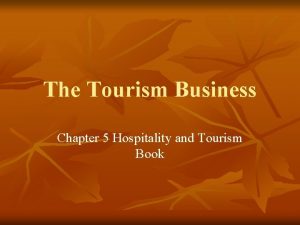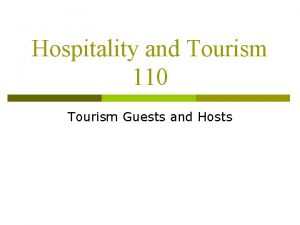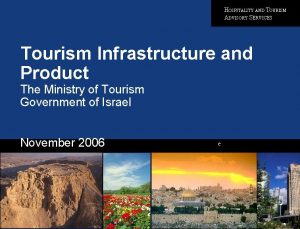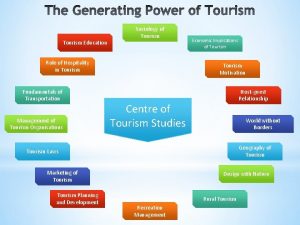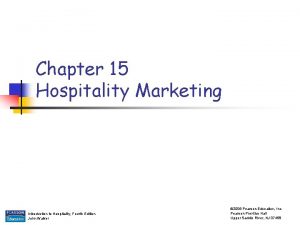Intro to Tourism Hospitality Chapter 12 Copyright Introduction






































- Slides: 38

Intro to Tourism & Hospitality Chapter 12

Copyright Introduction to Tourism and Hospitality in BC by Morgan Westcott, Editor, (c) Capilano University is used under a CC-BY 4. 0 International license. This chapter is by Keith Henry and Terry Hood and is used under a CC-BY 4. 0 International license.

Learning Objectives Describe the socio-political context for Aboriginal tourism development Identify steps taken to uphold indigenous rights as they relate to tourism in developing nations Discuss the evolution of Aboriginal tourism in Canada and its connection to cultural/heritage tourism Describe approaches taken to strengthen and increase the number of Aboriginal tourism businesses in Canada and BC Describe the stages of market readiness and how these relate to Aboriginal tourism products and experiences (Henry & Hood, n. d. )

Learning Objectives Explain the concept of authenticity and the challenges in delivering authentic visitor experiences Articulate the importance of community involvement and effective partnerships in developing Aboriginal tourism businesses Recognize the value of Aboriginal tourism to BC’s tourism industry, and key agencies responsible for its development Relate success stories in Aboriginal tourism business operations and collaborations in BC, Canada, and elsewhere (Henry & Hood, n. d. )

Definitions Indigenous peoples are those groups protected under international or national legislation as having specific rights based on their historical ties to a particular territory and their cultural or historical distinctiveness from other populations (Coates, 2004).

Definitions Indigenous people in Canada are often called First peoples or Aboriginal peoples and have diverse languages, ceremonies, traditions, and histories. The Canadian Constitution Act recognizes three groups of Aboriginal people: First Nations, Inuit, and Métis. (Henry & Hood, n. d. )

Human Rights Tourism has created exploitation of indigenous peoples Land has been expropriated Economic activity has been suppressed by outside interests Cultural expressions (such as arts and crafts) have been appropriated by outside groups (Henry and Hood, n. d. )

Human Rights Declaration on the Rights of Indigenous People This marked a significant achievement in obtaining international recognition of key rights, including, but not limited to, self-determination, land use, and natural resources rights. It set forth the minimum standards for the survival, dignity, and well-being of the indigenous peoples of the world (United Nations, 2007).

Larrakia Declaration 2012 the Pacific Asia Travel Association organized a gathering of global indigenous tourism professionals to establish guiding principles for the development of indigenous tourism These principles are now known as the Larrakia Declaration on the Development of Indigenous Tourism, named after the Larrakia Nation, the Australian Aboriginal host community for the meeting (PATA & WINTA, 2014)

Larrakia Declaration Figure 12. 2 This “We Don’t Climb” sign expresses the traditional laws of Australian Aboriginal people and asks that tourists not climb Uluru (once known as Ayers Rock). In the background, dozens of people continue to climb

Larrakia Declaration Principles “Respect for customary law and lore, land water, traditional knowledge, traditional cultural expressions, cultural heritage that will underpin all tourism decisions. Indigenous culture, the land waters on which it is based, will be protected and promoted through well managed tourism practices and appropriate interpretation. Indigenous peoples will determine the extent, nature and organisational arrangements for their participation in tourism and that governments and multilateral agencies will support the empowerment of Indigenous people. ” (World Indigenous Tourism Alliance, 2012, pp. 1 -2)

Larrakia Declaration Principles “That governments have a duty to consult and accommodate Indigenous peoples before undertaking decisions on public policy and programs designed to foster the development of Indigenous tourism. The tourism industry will respect Indigenous intellectual property rights, cultures and traditional practices, the need for sustainable and equitable business partnerships and the proper care of the environment and communities that support them. That equitable partnerships between the tourism industry and Indigenous people will include the sharing of cultural awareness and skills development which support the wellbeing of communities and enable enhancement of individual livelihoods. ” (World Indigenous Tourism Alliance, 2012, pp. 1 -2)

First Nations People Aboriginal peoples who do not identify as Inuit or Métis Have lived across present-day Canada for thousands of years and have numerous languages, cultures, and spiritual beliefs With the formation of the country of Canada, their way of life was changed forever (Wilson & Henderson, 2014)

First Nations People The government forced a system of band governance on First Nations so that they could no longer use their system of government There are now 203 bands in BC, and 614 across the country (Wilson & Henderson, 2014)

First Nations People Figure 12. 3 First Nations performer at the opening of the Aboriginal Pavilion for the 2010 Olympic and Paralympic Games

First Nations People Colonial settlement has left a legacy of land displacement, economic deprivation, and negative health consequences that Canada’s First Nations are still striving to overcome Indian (or Native Indian) is still an important legal term in Canada, but many Aboriginal people associate it with government regulation and colonialism and its use has gone out of favour, unlike in the United States where American Indian is still common (Wilson & Henderson, 2014)

Inuit Have lived in the Arctic region of Canada for countless years Many Inuit still rely on the resources of the land, ice, and sea to maintain traditional connections to the land Old ways of life were seriously compromised, however, when Inuit began to participate with European settlers in the fur trade (Wilson & Henderson, 2014)

Inuit communities focus on protecting their traditional way of life and language Non-Inuit people used to call Inuit people Eskimo, but this is now considered insulting and should be avoided (Wilson & Henderson, 2014)

Métis Comes from the words to mix 1600 s and 1700 s, many French and Scottish men migrated to Canada for the fur trade Some of them had children with First Nations women and formed new communities, and their people became the first to be called Métis (Henry & Hood, n. d. )

Métis The distinct Métis culture is known for its fine beadwork, fiddling, and jigging Tourism can promote community and economic development while preserving indigenous culture (Henry & Hood, n. d. )

Aboriginal Tourism There has always been some demand among visitors to Canada to learn more about Aboriginal heritage, driven by the strong interest of Europeans in particular Over the last 20 years or so, steps have been taken to support authentic Aboriginal cultural products and experiences and to counter decades of appropriation of Aboriginal symbols and arts and crafts by non. Aboriginal Canadians (Henry & Hood, n. d. )

Aboriginal Tourism Aboriginal exhibits and displays were developed for tourism attractions and museums by well-meaning non-Aboriginals who did not consult with local communities Souvenir shops were often filled with inexpensive overseas-made replicas of authentic Aboriginal arts and crafts (Henry & Hood, n. d. )

Aboriginal Tourism Figure 12. 4 Cultural products for sale as souvenirs

Aboriginal Tourism 1980 s and 1990 s, the federal government initiated discussions on Aboriginal tourism The outcome was the formation of several national organizations such as Aboriginal Tourism Team Canada (ATTC) These groups started the trend of defining Aboriginal cultural tourism standards and promotion Today, these functions are performed by the Aboriginal Tourism Association of Canada (ATAC) (Henry & Hood, n. d. )

Aboriginal Tourism “Aboriginal tourism: describes all tourism businesses that are majorityowned and operated by First Nations, Métis and Inuit. They must also demonstrate a connection and responsibility to the local Aboriginal community and traditional territory where the operation resides. Aboriginal cultural tourism: meets the Aboriginal tourism criteria and in addition, a significant portion of the experience incorporates Aboriginal culture in a manner that is appropriate, respectful and true to the Aboriginal culture being portrayed. The authenticity is ensured through the active involvement of Aboriginal people in the development and delivery of the experience. Aboriginal cultural experiences: offer the visitor a cultural experience in a manner that is appropriate, respectful and true to the Aboriginal culture being portrayed. ” (Aboriginal Tourism Association of Canada, 2013, p. 4)

Aboriginal Tourism is becoming a major economic and cultural driver for Aboriginal communities across Canada Tourism is of significant interest to growing numbers of Aboriginal communities in Canada

Aboriginal Tourism Resources such as the Aboriginal Cultural Tourism Business Planning Guide, can provide the foundational building blocks necessary to run a successful and authentic Aboriginal tourism business Figure 12. 5 Cover of Aboriginal Cultural Tourism Business Planning Guide

Aboriginal Tourism As an Elder once stated, Aboriginal tourism businesses showcase “culture, heritage and traditions, ” and “because these belong to the entire community, the community should have some input” (Aboriginal Tourism BC & CTHRC, 2013, p. 19). For this reason, the guide suggests operators consider the extent to which: Community members understand the project or business as it is being proposed Keepers of the culture are engaged in the development of the idea The business or experience reflects community values

Aboriginal Tourism Over the past decades, hundreds of Aboriginal-focused tourism experiences have developed in Canada. Examples include: The Head-Smashed-In Buffalo Jump interpretive centre in Alberta Northern lights viewing with indigenous hosts at Aurora Village in Yellowknife, Northwest Territories Essipit whale watching with the Innu in Quebec Driving the Great Spirit Circle Trail of Aboriginal experiences on Manitoulin Island in Ontario (Henry & Hood, n. d. )

Aboriginal Tourism Figure 12. 6 A group of visitors listen to an Aboriginal guide at Head-Smashed-In Buffalo Jump, Alberta

Aboriginal Tourism in BC Aboriginal Tourism Association of BC (At. BC) was founded in 1996 At. BC created a work plan, established funding partnerships with governments, developed a membership model, and initiated a range of strategies and tactics outlined in two five-year plans (Aboriginal Tourism BC, 2012)

Aboriginal Tourism in BC At. BC has grown to represent over 150 diverse stakeholder businesses Has become world renowned for its strategic approach to Aboriginal tourism development (Aboriginal Tourism BC, 2012)

Aboriginal Tourism in BC In 2012, At. BC released its five-year strategic plan, which identified targets for Aboriginal cultural tourism industry success. Its goals by 2017 included (Aboriginal Tourism BC, 2012): Increased provincial revenue of $68 million (10% growth per year) Employment at 4, 000 full-time equivalent positions (10% growth per year) 100 market-ready Aboriginal cultural tourism businesses (10% growth per year in all six BC tourism regions)

Aboriginal Tourism in BC To achieve these targets, the plan identified key strategies, reviewed and adjusted annually, such as (Aboriginal Tourism BC, 2013): Push for market readiness Build and strengthen partnerships Focus on online marketing Focus on key and emerging markets Focus on authenticity and quality assurance Take a regional approach

Aboriginal Tourism in BC Examples of BC Aboriginal tourism enterprises include: The Bill Reid Gallery of Northwest Coast Art in the heart of downtown Vancouver, home of the permanent collection of Bill Reid as well as contemporary exhibitions St. Eugene Golf Resort Casino, a First Nation-owned 4. 5 -star hotel with a golf course and casino, outside of Cranbrook in the Kootenay Rockies Cariboo Chilcotin Jetboat Adventures, offering exciting and scenic tours of the Fraser River Quw’utsun’ Cultural and Conference Centre, owned by the Cowichan band in Duncan Salmon n’ Bannock Bistro, offering authentic Aboriginal food in urban Vancouver The village of Ninstints (Nans Dins), a UNESCO world heritage site located on a small island off the west coast of Haida Gwaii (Henry & Hood, n. d. )

Aboriginal Tourism in BC Figure 12. 11 Sunrise at St. Eugene Mission Resort owned by the Ktunaxa, the Samson Cree, and the Mnjikaning First Nations

References Aboriginal Tourism Association BC & Canadian Tourism Human Resource Council (CTHRC). (2013). Aboriginal cultural tourism business planning guide. Retrieved from http: //linkbc. ca/site. Files/85/files/ACTBPG. pdf Aboriginal Tourism Association of Canada (as Aboriginal Tourism Marketing Circle). (2013). Aboriginal cultural tourism guide. Retrieved from http: //aboriginaltourismmarketingcircle. ca/wp-content/uploads/2014/01/Aboriginal. Cultural. Experiences. Guide_2013 -s. pdf Aboriginal Tourism BC. (2012). The next phase (2012 -2017): A five-year strategy for Aboriginal cultural tourism in BC. Retrieved from www. aboriginalbc. com/assets/corporate/The%20 Next%20 Phase%20 -%20 BCs%20 Aboriginal%20 Cultural%20 Tourism%20 Strategy%20 -%20 At. BC. pdf Aboriginal Tourism BC. (2013). The next phase (2012 -2017): A five-year strategy for Aboriginal cultural tourism in BC: Year one report. Retrieved from www. aboriginalbc. com/assets/At. BC-5 -Year-Plan-2012 -2017 -The-Next-Phase-Year-1 -Keith-Henry. pdf Coates, Ken S. (2004). A global history of indigenous peoples: Struggle and survival. New York, NY: Palgrave Mac. Millan. p 12 ISBN 0 -333 -92150 -X. Henry, K. & Hood, T. (n. d. ) Aboriginal Tourism. In Westcott, M. Editor, Introduction to Tourism and Hospitality in BC (pp. 276 -298). Retrieved from http: //opentextbc. ca/introtourism/chapter-12 -aboriginal-tourism/ Pacific Asia Travel Association (PATA) and World Indigenous Tourism Alliance (WINTA). (2014). Indigenous Tourism and human rights in Asia and Pacific Region: Review, analysis & guidelines. Bangkok, Thailand: PATA. United Nations. (2007). UN declaration on the rights of indigenous people. www. un. org/esa/socdev/unpfii/documents/DRIPS_en. pdf Wilson, K. & Henderson, J. (2014, March 3). First Peoples: A guide for newcomers. Vancouver: City of Vancouver. Retrieved from http: //vancouver. ca/files/cov/First -Peoples-A-Guide-for-Newcomers. pdf World Indigenous Tourism Alliance. (2012). Larrakia declaration on indigenous tourism. www. winta. org/wp-content/uploads/2012/08/The-Larrakia. Declaration. pdf

Attributions Figure 12. 2 We Don’t Climb by Steel Wool is used under a CC-BY-NC-ND 2. 0 license. Figure 12. 3 First Nations performers during the opening ceremony by Province of BC is used under a CC BY-NC-SA 2. 0 license. Figure 12. 4 Animal and ‘native’ cultural products by Toban B is used under a CC-BY-NC 2. 0 license. Figure 12. 5 Cover of the Aboriginal Cultural Tourism Business Planning Guide by Link. BC is used under a CC-BY-NC-ND 2. 0 license. Figure 12. 6 head smashed in buffalo jump by Roland Tanglao is used under a CC-BY 2. 0 license. Figure 12. 11 Cranbrook by Province of British Columbia is used under a CC-BY-NC-ND 2. 0 license.
 Introduction to hospitality and tourism industry
Introduction to hospitality and tourism industry Hospitality marketing
Hospitality marketing Chapter 2 hospitality and tourism
Chapter 2 hospitality and tourism Intro to tourism
Intro to tourism Tourism the business of hospitality and travel
Tourism the business of hospitality and travel 8 sector of tourism
8 sector of tourism Marketing for hospitality and tourism 7th edition ppt
Marketing for hospitality and tourism 7th edition ppt John r walker introduction to hospitality management
John r walker introduction to hospitality management Hospitality and tourism final exam
Hospitality and tourism final exam Internal marketing in tourism
Internal marketing in tourism Contemporary issues in tourism meaning
Contemporary issues in tourism meaning Principles of hospitality and tourism lesson plans
Principles of hospitality and tourism lesson plans 8 sectors of tourism
8 sectors of tourism Interrelated nature of hospitality and tourism
Interrelated nature of hospitality and tourism History of hospitality and tourism industry
History of hospitality and tourism industry E commerce tools in tourism and hospitality
E commerce tools in tourism and hospitality Aoht principles of hospitality and tourism
Aoht principles of hospitality and tourism Aoht principles of hospitality and tourism
Aoht principles of hospitality and tourism The origins of hospitality and tourism
The origins of hospitality and tourism The origins of hospitality and tourism
The origins of hospitality and tourism 8 sectors
8 sectors Unit 20 hospitality operations in travel and tourism
Unit 20 hospitality operations in travel and tourism Who established rest houses for pilgrims in europe?
Who established rest houses for pilgrims in europe? The origins of hospitality and tourism
The origins of hospitality and tourism Marketing for hospitality and tourism pearson
Marketing for hospitality and tourism pearson Mass tourism vs alternative tourism
Mass tourism vs alternative tourism Strategic hospitality technology investment
Strategic hospitality technology investment Introduction to hospitality 7th edition
Introduction to hospitality 7th edition Introduction to hospitality 7th edition
Introduction to hospitality 7th edition Introduction to hospitality 7th edition
Introduction to hospitality 7th edition John r walker introduction to hospitality management
John r walker introduction to hospitality management Chapter 10 marketing answer key
Chapter 10 marketing answer key Intro to business chapter 7 study guide
Intro to business chapter 7 study guide Introduction to business chapter 8
Introduction to business chapter 8 Anaerobic exercise physiology
Anaerobic exercise physiology Chapter 1 introduction to forensic science and the law
Chapter 1 introduction to forensic science and the law Intro to business chapter 10
Intro to business chapter 10 Tourism introduction
Tourism introduction Tourism introduction
Tourism introduction
